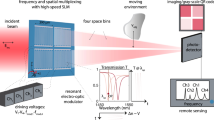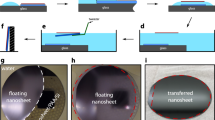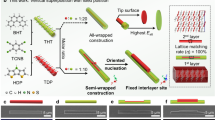Abstract
A crucial goal for modern telecommunications systems is development of very high-speed components for broadband (>100 GHz), all-optical signal/information processing. The core component of such technologies is the electro-optic modulator, which encodes electrical signals onto fibre-optic transmissions. A significant challenge therefore is obtaining materials that have large electro-optic responses and that can be readily fabricated into devices at low cost. We report here on the realization of high-response heteroaromatic organic chromophores that can be straightforwardly self-organized from the vapour phase into intrinsically acentric, high-quality, micrometre-scale films. These π-conjugated electro-optically active films (with second-order susceptibilities up to ∼100 pm V−1) are thermally stable and conveniently grown by a simple physical vapour deposition process in a few hours. Supramolecular acentricity is achieved without electric field poling, enforced by biomimetic heterocycle–hydroxycarbonyl head-to-tail hydrogen-bonding.
This is a preview of subscription content, access via your institution
Access options
Subscribe to this journal
Receive 12 print issues and online access
$259.00 per year
only $21.58 per issue
Buy this article
- Purchase on SpringerLink
- Instant access to full article PDF
Prices may be subject to local taxes which are calculated during checkout








Similar content being viewed by others
References
Ma, H., Jen, A. K.-Y. & Dalton, L. R. Polymer-based optical waveguides: materials, processing, and devices. Adv. Mater. 14, 1339–1365 (2002).
Lee, M. et al. Broadband modulation of light by using an electro-optic polymer Science 298, 1401–1404 (2002).
Van der Boom, M. E. Nanostructured molecular materials for device-quality, highly efficient electrooptic poled polymers. Angew. Chem. Int. Edn 41, 3363–3366 (2002).
Zyss, J. (ed.) Molecular Nonlinear Optics—Materials, Physics and Devices (Academic, San Diego, 1994).
Prasad, P. N. & Williams, D. J. Introduction to Nonlinear Optical Effects in Molecules and Polymers (Wiley, New York, 1991).
Marder, S. R., Kippelen, B., Jen, A. K. Y. & Peyghambarian, N. Design and synthesis of chromophores and polymers for electro-optic and photorefractive applications. Nature 388, 845–851 (1997).
Yesodha, S. K., Sadashiva Pillai, C. K. & Tsutsumi, N. Stable polymeric materials for nonlinear optics: a review based on azobenzene systems. Progr. Polym. Sci. 29, 45–74 (2004).
Hu, Z.-Y. et al. Trends in optical nonlinearity and thermal stability in electrooptic chromophores based upon the 3-(dicyanomethylene)-2,3-dihydrobenzothiophene-1, 1-dioxide acceptor. J. Phys. Chem. B 108, 8626–8630 (2004).
Ma, H. et al. Highly efficient and thermally stable electro-optical dendrimers for photonics. Adv. Funct. Mater. 12, 565–574 (2002).,
Le Bouder, T. et al. Synthesis, photophysical and nonlinear optical properties of macromolecular architectures featuring octupolar tris(bipyridine) ruthenium(II) moieties: evidence for a supramolecular self-ordering in a dendritic structure. J. Am. Chem. Soc. 125, 12284–12299 (2003).
Brusatin, G. et al. Hybrid organic-inorganic materials containing poled zwitterionic push-pull chromophores. J. Eur. Ceram. Soc. 24, 1853–1856 (2004).
Shi, Y. et al. Low (sub-1-volt) halfwave voltage polymeric electro-optic modulators achieved by controlling chromophore shape. Science 288, 119–122 (2000).
Schwartz, H. et al. Langmuir and Langmuir–Blodgett films of NLO active 2-(p-N-Alkyl-N-methylamino)benzylidene-1,3-indandione-π/A curves, UV-Vis spectra, and SHG behavior. UV-Vis spectra, and SHG behavior. J. Phys. Chem. B 105, 5914–5921 (2001).
Ashwell, G. J., Jackson, P. D. & Crossland, W. A. Non-centrosymmetry and second-harmonic generation in Z-type Langmuir–Blodgett films. Nature 368, 438–40 (1994).
Facchetti, A. et al. Layer-by-layer self-assembled pyrrole-based donor-acceptor chromophores as electro-optic materials. Chem. Mater. 15, 1064–1072 (2003).
Van der Boom, M. E. et al. Nanoscale consecutive self-assembly of thin-film molecular materials for electrooptic switching. Chemical streamlining and ultrahigh response chromophores. Langmuir 18, 3704–3707 (2002).
Lin, W., Lin, W., Wong, G. K. & Marks, T. J. Supramolecular approaches to second-order nonlinear optical materials. Self-assembly and microstructural characterization of intrinsically acentric [(aminophenyl)azo]pyridinium superlattices. J. Am. Chem. Soc. 118, 8034–8042 (1996).
Lehn, J.-M. Toward self-organization and complex matter. Science 295, 2400–2403 (2002).
Corbin, P. S., Zimmerman, S. C., Thiessen, P. A., Hawryluk, N. A. & Murray, T. J. Complexation-induced unfolding of heterocyclic ureas. Simple foldamers equilibrate with multiply hydrogen-bonded sheetlike structures. J. Am. Chem. Soc. 123, 10475–10488 (2001).
Whitesides, G. M., Mathias, J. P. & Seto, C. T. Molecular self-assembly and nanochemistry: a chemical strategy for the synthesis of nanostructures. Science 254, 1312–1319 (1991).
Etter, M. C., MacDonald, J. C. & Bernstein, J. Graph-set analysis of hydrogen-bond patterns in organic crystals. Acta Cryst. B 46, 256–62 (1990).
Rashid, A. N., Erny, C. & Gunter, P. Hydrogen-bond-directed orientation in nonlinear optical thin films. Adv. Mater. 15, 2024–2027 (2003).
Zhu, P. et al. Vapor phase self-assembly of electrooptic thin films via triple hydrogen bonds. J. Am. Chem. Soc. 125, 11496–11497 (2003).
Barth, J. V. et al. Stereochemical effects in supramolecular self-assembly at surfaces: 1-D versus 2-D enantiomorphic ordering for PVBA and PEBA on Ag(111). J. Am. Chem. Soc. 124, 7991–8000 (2002).
Saadeh, H., Wang, L. & Yu, L. Supramolecular solid-state assemblies exhibiting electrooptic effects. J. Am. Chem. Soc. 122, 546–547 (2000).
Cai, C. et al. Self-assembly in ultrahigh vacuum. Growth of organic thin films with a stable in-plane directional order. J. Am. Chem. Soc. 120, 8563–8564 (1998).
Forrest, S. R. Ultrathin organic films grown by organic molecular beam deposition and related techniques. Chem. Rev. 97, 793–1896 (1997).
Abbotto, A. et al. Novel heteroaromatic-based multi-branched dyes with enhanced two-photon absorption activity. Chem. Commun. 17, 2144–2145 (2003).
Abbotto, A., Bradamante, S., Facchetti, A. & Pagani, G. A. Facile, regioselective synthesis of highly solvatochromic thiophene-spaced N-alkylpyridinium dicyanomethanides for second-harmonic generation. J. Org. Chem. 62, 5755–5765 (1997).
Bradamante, S., Facchetti, A. & Pagani, G. A. Heterocycles as donor and acceptor units in push-pull conjugated molecules. Part 1. J. Phys. Org. Chem. 10, 6514–524 (1997).
Oudar, J. L. & Chemla, D. S. Hyperpolarizabilities of the nitroanilines and their relations to the excited state dipole moment. J. Chem. Phys. 66, 2664–2668 (1977).
Kajzar, F., Messier, J., Zyss, J. & Ledoux, I. Nonlinear interferometry in Langmuir–Blodgett multilayers of polydiacetylene. Opt. Comm. 45, 133–137 (1983).
Simpson, G. J. & Rowlen, K. L. An SHG magic angle: dependence of second harmonic generation orientation measurements on the width of the orientation distribution. J. Am. Chem. Soc. 121, 2635–2636 (1999).
Bloembergen, N. & Pershan, P. N. Light waves at the boundary of nonlinear media. Phys. Rev. 128, 606–622 (1962).
Haller, M. et al. A novel lattice-hardening process to achieve highly efficient and thermally stable nonlinear optical polymers. Macromolecules 37, 688–690 (2004).
Dalton, L. R. et al. From molecules to opto-chips: organic electro-optic materials. J. Mater. Chem. 9, 1905–1920 (1999).
Lundquist, P. M. et al. Dispersion of second-order optical nonlinearity in chromophoric self-assembled films by optical parameters amplification: experiment and theory. Appl. Phys. Lett. 64, 2194–2196 (1994).
Steiner, T. The hydrogen bond in the solid state. Angew. Chem. Int. Edn 41, 48–76 (2002).
Lundquist, P. M. Electro-optical characterization of poled-polymer films in transmission. Appl. Phys. Lett. 69, 901–903 (1996).
Kuzyk, M. G. & Dirk C. W. in Characterization Techniques and Tabulations for Organic Nonlinear Optical Materials (Marcel Dekker, New York, 1998).
Sigelle, M. & Hierle, R. Determination of the electrooptic coefficients of 3-methyl-4-nitropyridine 1-oxide by an interferometric phase-modulation technique. J. Appl. Phys. 52, 4199–4204 (1981).
Acknowledgements
We thank DARPA/ONR (SP01P7001R-A1/N00014-00-C), the NSF MRSEC program (DMR 0076077), and INSTM for financial support. E.A. thanks CNR for a postdoctoral fellowship. We also thank A. Abbotto and H. Kang for discussions, P. Dutta and G. Evmenenko for XRR data, and S.-T. Ho and Z. Liu for preliminary electro-optic coefficient measurements.
Author information
Authors and Affiliations
Corresponding authors
Ethics declarations
Competing interests
The authors declare no competing financial interests.
Rights and permissions
About this article
Cite this article
Facchetti, A., Annoni, E., Beverina, L. et al. Very large electro-optic responses in H-bonded heteroaromatic films grown by physical vapour deposition. Nature Mater 3, 910–917 (2004). https://doi.org/10.1038/nmat1259
Received:
Accepted:
Published:
Issue date:
DOI: https://doi.org/10.1038/nmat1259
This article is cited by
-
Synthesis, growth, frontier molecular orbitals, fracture mechanics and nonlinear optical studies of l-serine methyl ester hydrochloride single crystal
Journal of Optics (2018)
-
Theoretical assessment of the nonlinear optical properties of substituted oligoacenes
Journal of Materials Science (2013)
-
Self-assembly reaches new heights
Nature Materials (2004)



